You are currently browsing the market crash category
So way back when on that post I made about Turok: Dinosaur Hunter #1’s solicitation, Chris V flew in with
“I never realized that Turok was considered a sales failure. I was always under the impression that it sold really well.”
To be fair, I did state that first issue experienced “relative sales failure (relative to its massively excessive orders, I mean).” I’m sure it did sell an enormous number of copies. There had been a lot of anticipation for it at the time, after all. But as I said, compared to the huge numbers retailers actually ordered and still had stuck in their backrooms (until they were dumped in the shredder, natch)…well, it didn’t sell up to preorder expectations.
It was technically a success for Valiant, as they still got paid for all the copies they shipped. (Though it was perhaps the beginning of the beginning of the beginning of the end for that iteration of the company.) But it was a marketplace failure, in that many copies were left unsold, and it was a retailer failure, most of them ordering way too many to begin with.
The comic because one of the symbols of the excesses of 1990s comics retailing, maybe not directly causing that decade’s market crash but it certainly didn’t prevent it. As such, despite actually being a not half-bad comic, it gets lumped in with Deathmate and other ill-received books from the time, symptoms of a sick marketplace that needed to get worse before it got (slightly) better.
More of your questions/comments responded to next week! Stay tuned!
So back in 1968, Mad Magazine pulled this cover gag on issue #123:
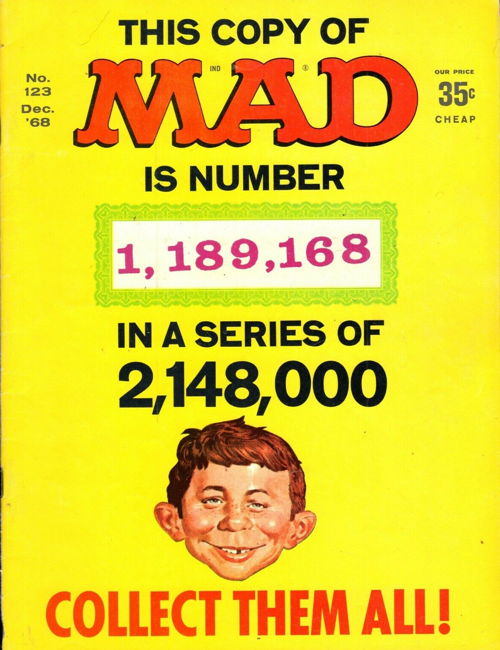
…part of the joke being there were only (as far as anyone knows) four different serial numbers printed on the covers. In essence, that makes this one of the first “variant” covers in the modern sense (predating that darn Man of Steel #1).
Now, I don’t think anyone expected fans to actually collect all four variants, despite what it says there on the cover. Clearly the multiple printed numbers were only there to add a bit of verisimilitude to the gag. Now of course Mad would eventually, actually, once the technology existed, put genuine serialized numbering on some covers, like this issue from 1995:
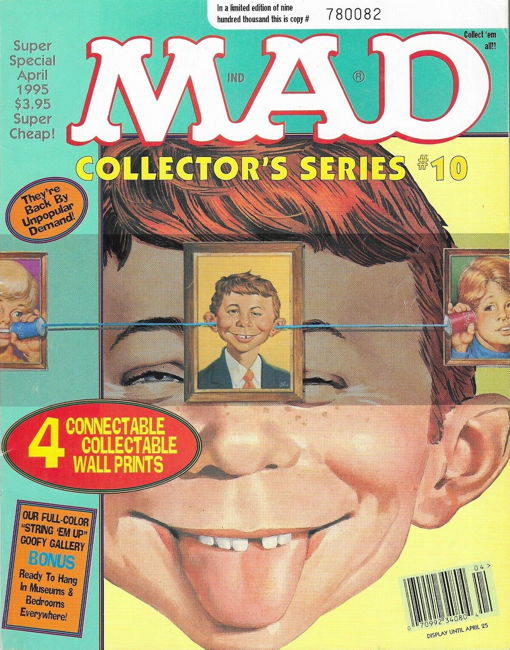
This reminds me of ack in ye olden tymes of the 1980s, I was, I don’t know, 12 or 13 or something like that, when I first saw a printed personlized message in one of the magazines to which I subscribed. (It was either Games or Omni — yes I know that’s a little weird.) Not just my address being printed directly onto the cover instead of being printed first on a mailing label that was glued to the mag. But an actual message to me, using my name, printed (and memory fails me here, as I haven’t thought about this in decades) on the cover, or inside the magazine itself. Look, I don’t know when this sort of thing became available, if it’d been happening elsewhere before it showed up in the mags I read, but all I know is that I thought that was pretty cool. My copy of the magazine was personalized to me, and totally different from everyone else’s copy, which technically was true before anyway just given the mailing label, but you know what I mean. But it was only a short leap from this to putting a sequence of “limited edition” serial numbers on a cover.
For the purposes of my ongoing discussion, this type of “variant” cover I’ve been discussing only just barely counts. Well, Mad #123 does, obviously, but the others…when we think of variant covers on comics, we’re likely thinking of comics marketed with two or more covers, often with differing art or enhancements or even just coloring.
Also, there’s intent…the typical variant covers are there to either get a customer to buy more than one cover, or to provide enough variations that a customer otherwise possibly not interested in the publication might spot a cover he likes and is enticed to buy.
Serial numbers printed on a comic’s cover are a sales enticement as well, but not in the same way. Different numbers on different copies do make them variants, when you get down to it, but, like no one’s literally “collecting them all.” Or, come to think of it, maybe someone’s trying…I’ve been in comics retail for nearly three and a half decades, I know what kind of stuff you weirdos get up to. That said, a serial number implies “limited edition” — “there’s only so many of these in existence!” — so that part of it does (or hopefully does) get a customer’s attention and with it, a purchase.
One publisher that took it to an extreme, and made serial numbering part of their trade dress, was Triumphant Comics:
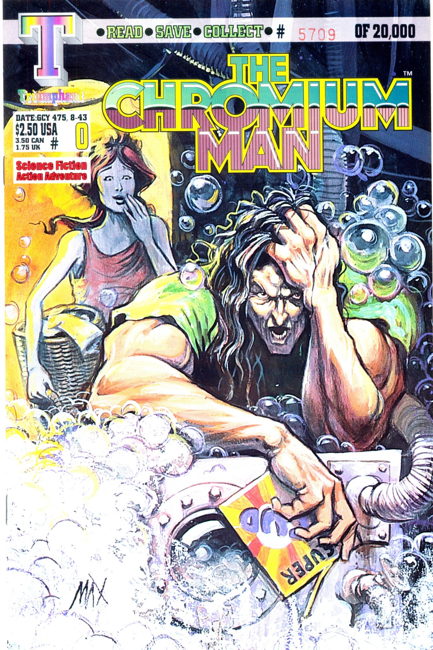
A closer look:

I’m trying to remember how these specifically sold for us at the shop at the time, and alas that data was expunged from my brain at some point over the years. I do remember not having much, if any, back issue movement on them, either at the time or well after the fact, a combination of general market malaise in the 1990s crash times, along with the fact the company itself was only around a year or so.
The print runs probably looked impossibly small at the time, after the huge successes of X-Men #1 and X-Force #1 and all that nonsense moving millions of copies into shops, a portion of those then even selling to customers. Having a comic with a 12,500 print run and being serially numbered probably looked like a collectibility and-therefore-sales-slam-dunk:
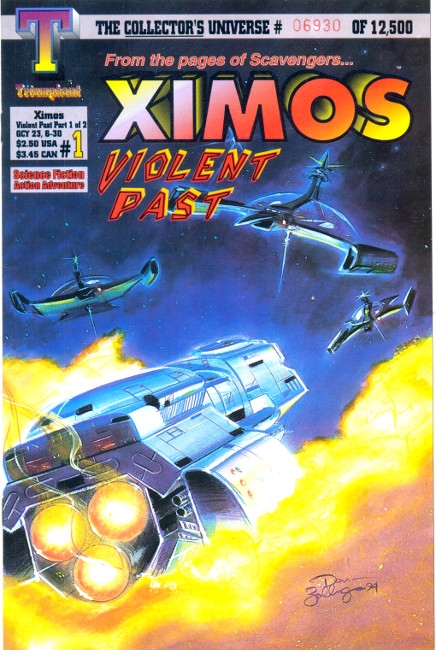
Just kinda randomly picking through the comics, stated print runs of between about 15,000 to 30,000 were the most common. The outlier was this freebie comic which, being free, naturally had the largest number that I saw:
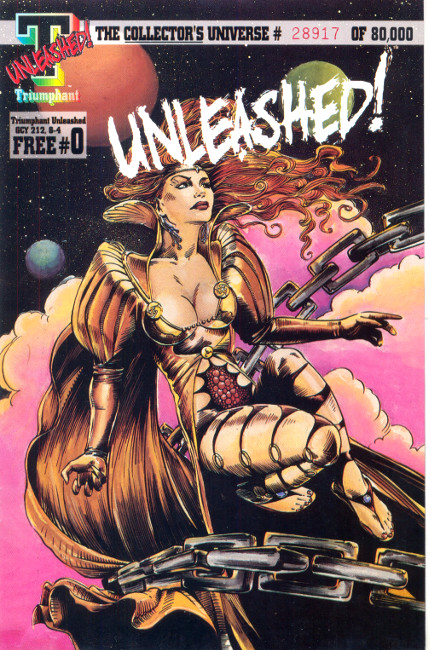
Not much else to say here really…their publishing strategy was to make their comics look more collectible, and, well, you can get copies for a buck a pop on eBay (one listing for a single issue for $5.99 including free shipping…which basically makes that a buck as well). Anyway, it was an interesting try at a gimmick building off a market with multiple price guides and an expanded emphasis on “limited editions” and “collectibles,” done in, it seems, by that market suddenly going away.
These is one more thing I’d like to point out, and that was this letter of encouragement from another comics personality of note that was printed on a back cover:
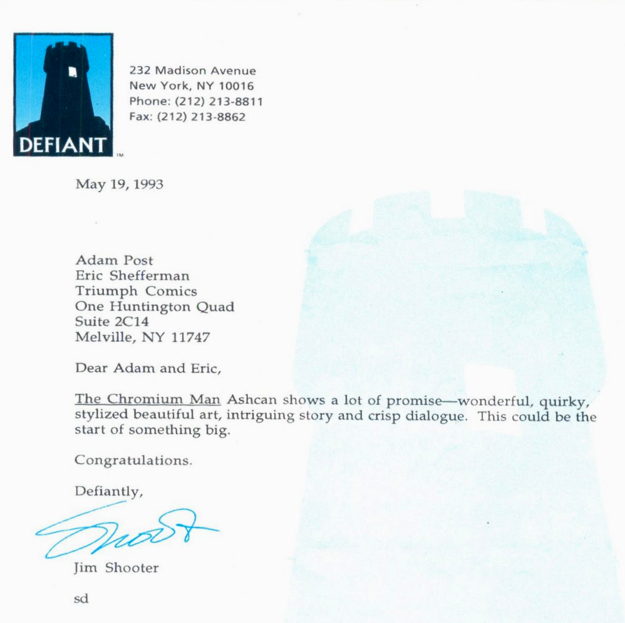
Which reminds me…I hope none of my comments here are taken as disparaging of the actual contents of these books. I’ve…never actually read a Triumphant comic. Big Jim liked what he saw, anyway. But this year’s worth of Triumphant books represented someone’s hard work and effort and dream to get their stories into print, and good for them. They had an interesting hook with the serial numbers to stand out on the shelves, but unfortunately things just didn’t work out. That’s just how it goes sometimes, and that’s especially how it went in comics during the mid-1990s.
Okay, next up in the variant cover-age…maybe some actual variant-ish type variant comics! Hey, did Defiant Comics have variants? I don’t remember.
Also, thanks to Customer Dave for lending me some of the Triumphant Comics from his collection for the production of this post. Hmmm, so long as I have ’em on hand, I’ll give one a read.
If you’re trying to decide “what’s the most famous example of variant comic covers of all time” — first, c’mon, what’re you doing with your life, and second, I think just through the sheer magnitude of copies that were unleashed upon an unsuspecting public, it’s gotta be 1991’s X-Men #1:
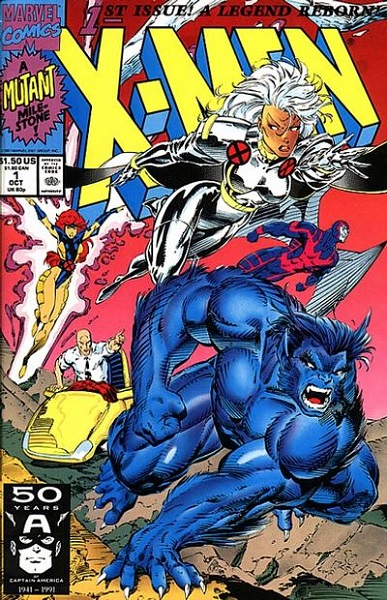
There were four different covers produced, the first three featuring a different mix of members of the team, with the final cover presenting their arch-nemesis Magneto. The four covers formed a single image when connected together, but if you didn’t trust your hand-eye coordination to assemble so complex a puzzle, Marvel had your back with the fifth variant: a gatefold cover that opened up to present the full image.
Unlike Spider-Man #1, the covers weren’t released all at once. Instead, Marvel decided to dominate comic sales for over a month by releasing each cover one per week, starting with the A, B, C and D covers (as they are usually referred to), culminating in the gatefold cover in the final week.
Orders were gargantuan. In total, over 8 million copies were produced, though as has been noted by multiple observers, and just through my own personal observation, a good chunk of those remained in retailers’ hands.
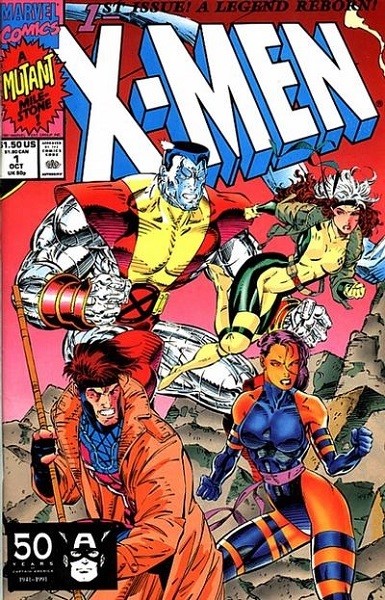
Speaking of personal observations, I’ve written in the past about how once impossibly-common comics from the ’90s marketplace are becoming slightly less easy to find in the wild, simply due to the attrition of stores that were active then having shut down in the intervening decades and taking their backstock with them. I’ve also written about how many of the people buying comics at the time either had no idea how to take care of their comics at the time (despite the wide variety of comic storage supplies being offered, and purchased, in sizeable amounts), or simply neglected their collections and let them fall to disuse and ruin over the years.
The point being…a comic that was once so commonplace and contemptuously familiar that copies were given away free with purchases is now, kinda sorta, becoming “collectible” again. Not to keep referring to things I’ve said in the past, but I’ve said in the past that even without actively buying copies of X-Men #1 in collections, I’m accumulating a backlog of it. And I’d say only abut a third of the copies I’ve seen have been in Near Mint or better, and when you actually have a copy in Near Mint (and not, say, VF- which you’re calling “Near Mint”) it can sell for a pretty good price nowadays.
Again, this all depends on local supply. There are probably still plenty of areas of High X-Men #1 Concentrations where they flow like water, and you merely need to dip your hand in a stream to retrieve a copy or three. And they’re all over eBay, natch. But, in areas populated primarily by newer stores, where even the bespectacled old men who have direct memories of those times and will gladly share them with you (ahem), they may not be as in deep a stock as they historically had been.
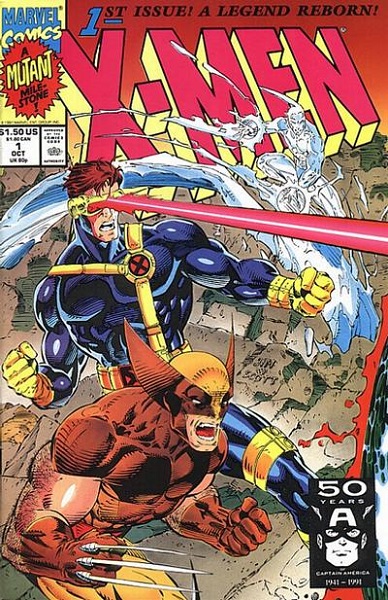
It was a large confluence of causes that resulting in this massive amount of orders:
- The ’90s were a boom time for collectible comics, with a huge influx of new customers driven to comic shops primarily by the 1989 Batman movie, with earlier successes like Dark Knight, Watchmen and Teenage Mutant Ninja Turtles helping to push the expanding market as well.
- It was the time of The Hot Artists, and Jim Lee may have been the hottest artist of the time. Launching an expansion of Marvel’s popular franchise with Lee on art chores couldn’t help but grab market attention.
- The investors were out in force. The aforementioned Teenage Mutant Ninja Turtles arguably kicked off a new wave of folks looking to make their fortune trading in “rare” comic books, and what could be rarer than eight million copies of X-Men #1? Okay, nobody knew it was going to sell that many copies, but it was a pretty easy guess that it was going to move some large numbers. That didn’t stop people from buying boatloads of copies in the hopes that they’d be able to turn them into houses or kids’ college funds down the road.
- This may be hard to imagine, but there was a time in comics publishing that when a new series was launched, the expectation was that the series would continue so long as sales held out, and maybe if sales dipped a little, the publisher would try things like “new directions” or “fresh creative teams” or more promotion to support the book. The idea that new #1s for titles would flash by like strobe lights was not one that was considered. As such, retailers would order plenty of first issues of titles, as that would likely be the most sought-after number in the back issue bins over the years, and hopefully decades, of the title’s life.
- And yes, the multiple covers. Outside of investors, just plain ol’ folk who bought comics and weren’t necessarily looking to turn a buck. As I brought up early on this ongoing series of “variant covers” posts, having different cover images was a way to encourage the regular reader to pick up more than one copy of a particular item. Plus, having the additional twist of making all the covers connect into a larger picture…it’s a cunningly evil plan that, I can tell you at least from my memories of selling the things at the time, worked quite well indeed.
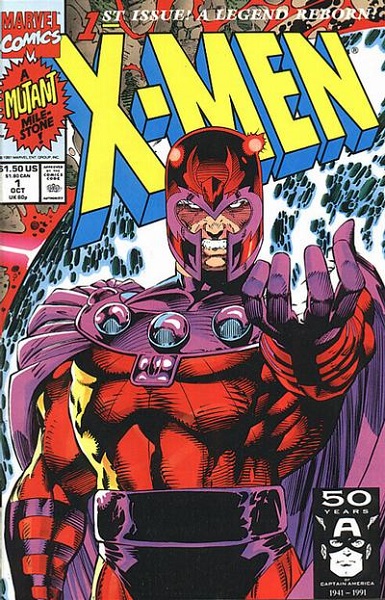
Some have pointed to this as being one of the causes of the ’90s market crash, and…I don’t know, I think there may be worse offenders (I won’t say any names, but the initials stand for Deathmate) since, all things considered, X-Men #1 actually sold (though again, not nearly as many as were ordered). There were bigger stinkers out there, at least to the point that X-Men wasn’t seen as a flop, whereas something like Turok: Dinosaur Hunter was. That said, I’m sure enough people got burned on their investments on ’90s comics, including X-Men #1, that they, and their money, fled the marketplace, reducing cash flow and feeding the crash.
So wither X-Men #1? It remains a popular seller, as do assorted issues from the 1991 series as a whole. There’s a whole new audience of comic book buyers and X-Men fans who weren’t around thirty years ago when this series launched. And there are plenty of customers who were around but misplaced, sold, or damaged their copies in the meantime and want replacements. And, of course, there’s the current wave of speculation mania driving sales on any “key” and/or first issues.
I don’t always have every cover in stock, but I usually have at least two or three different ones on hand. The cover I see the least? The gatefold cover. The one I see the most? Surprisingly, the fourth cover with Magneto, given that, according to this article, it was the poorest selling of the first four. And that gatefold cover was the highest selling. Huh, go figure. (Again, it all depends on how many copies actually got into people’s hands, and didn’t disappear with the retailers who ordered them.) It’s my memory that, as each cover was released every week, sales dropped a little with each one, with a boost on that final fold-out issue. But I could be wrong…it’s been 30 years, after all.
And which cover did I buy, since as a 1990s comics buyer you were legally required to buy at least one copy of X-Men #1? Why, the gatefold edition, of course…I wasn’t going to miss out on any of that artwork!
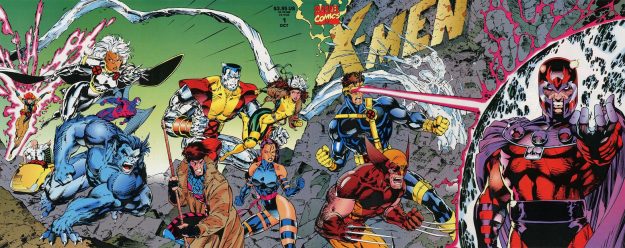
Next time in my variant cover-age, even though John kinda beat me to the punch: Robin comics! A whole lot of ’em! Holy gimmick covers, Batman!
So last week, when I was a’typin’ about the weirdo Marvel trading card boom allegedly going on right now, Matthew noted (in reference to X-Force (1991) #1’s involvement:
“You’ve mentioned the ‘Shazam! effect’ before in relation to the 1970s Shazam comic and I think there’s an element of that happening here too. I mean, X-Force #1 came out 30 years ago, that’s the same gap between Fantastic Four #1 and X-Force #1. Plus people who were young when it first came out our (potentially) old enough to have money and nostalgia for that thing they used to have?”
I did sort of refer to the Shazam Effect obliquely in that post in the following passage:
“…While millions of X-Force #1 were printed, that doesn’t necessarily follow that millions are out there in readily available circulation. And the ones that do turn up aren’t necessarily going to be in that minty-mint collectable condition.”
…and if someone out there doesn’t remember what that is…in short, the ’70s Shazam! #1 was ordered in huge quantities, with large amounts going unsold. It remained a cheap back issue for decades, often finding its way into quarter boxes and the like…until one day the market realized that actual nice copies were getting harder to come by. Partially due to age, but almost certainly a lot to do with available stock being dumped into said bargain boxes and basically being mishandled and poorly stored and such. And thusly, high grade Shazam! #1s go for a premium.
Now that’s my theory, built upon decades of observation and just how I know early on at the previous place of employment, we’ve just pour the buckets of Shazam! comics into the blow-out boxes and hoped someone would take them away.
This does apply to X-Force #1 (and other early ’90s blockbuster hit comics) a bit, I think. But first, I believe there were a lot more copies of X-Force #1 and its contemporaries printed than of Shazam! #1.
…And that while X-Force #1, in contrast to, say, the ’90s X-Men #1 and Spider-Man #1, did suffer in general reputation and consideration after the market sobered up a bit later in a decade, I don’t think quite the same percentage of them ended up in the bargain bin dregs to be misused and abused. Not saying no copies ended up there, but I believe it wasn’t enough to create a paucity of near mint copies in general circulation. If anything, like I said in my original post, actually being purchased by consumers who didn’t store their comics properly seems to be, just from my general experience, the more likely culprit in this matter.
There’s also the inverse relationship of product versus outlets to consider. Shazam #1 was released as the direct market was beginning, with more and more comic-specific retail stores opening up and presenting more opportunities for Shazam #1 to be sold. Even if, you know, it was just in quarter boxes. X-Force #1 was published just prior to the direct market’s near fatal contraction, with piles of unsold copies of that comic disappearing along with the stores that ordered too many of them. Assuming former store owners didn’t dump their stock on other surviving shops (or, uh, had them shredded), and also assuming proper and not contemptuous storage, there may be masses of mint-ish X-Force #1s still lurking, hidden, waiting to make their move.
Not saying every copy of those unsold Shazam!s got circulated, and that millions of X-Forces aren’t in circulation. But I do think there are potentially enough of those X-Force #1s out there in what would be considered “collectible” shape that all it really takes is one big warehouse/storage unit find for the supposed scarcity of that comic to dissipate. (If I recall correctly, something similar happened to Wally Wood’s Heroes Inc.) As garages and storage areas open up and get cleaned out by their owners, or progressively more often, surviving family members or third-party purchasers, they’re only going to become more common.
And going back to my original assertion, if there is an apparently scarcity to X-Force #1 at all, it comes from newer stores who weren’t around when it came out, and thus didn’t acquire an enormous backlog of unsold copies to dole out over the decades. Newer stores would have to acquire them in collections…and they do pop up there, time and again.
I hope none of this sounds like I’m trying to argue with commenter Matthew…just taking his response as a launching pad for considering the differences in situations here. Which isn’t to say his idea that “nostalgia + relatively shortness in supply” isn’t a fact. Sure it is. And that increased demand for a once moribund back issue is going to cause the prices to rise. But that Deadpool promo card going for hundreds of dollars…that’s almost certainly the result of folks trying to “force” a collectible, to find something relatively common in a market where genuinely scare items are becoming harder to come by, and declaring something “rare” and “hot.” Just by the natural order of things, I think any really high prices on these things is outside the normal causes of supply and demand.
Anyway, there you are. Over-rambly and self-contradictory, in the Mighty Mike Style, but there you go. If I were to sum up…while some price increases can be expected in even over-printed items like X-Force #1 due to a relative dearth of supply at current outlets, it’s still likely not rare enough to cause such extremely high pricing based on ordinary market forces. But none of that matters if it’s decided this is the new normal and that’s what these items go for now, regardless of abundance.
This is all conjecture and opinion based on what I’ve seen over my nearly 33 years in the industry. I could be (gasp) wrong, but this is my general sense of things. You know where to argue with me!
Thanks to Matthew for his response.
Okay, so apparently this is a thing that’s been happening. X-Force #1 from 1991…you know, the comic that sold, what, five million copies…which could be had for under ten bucks, usually closer to about a buck…is suddenly selling for premium prices.
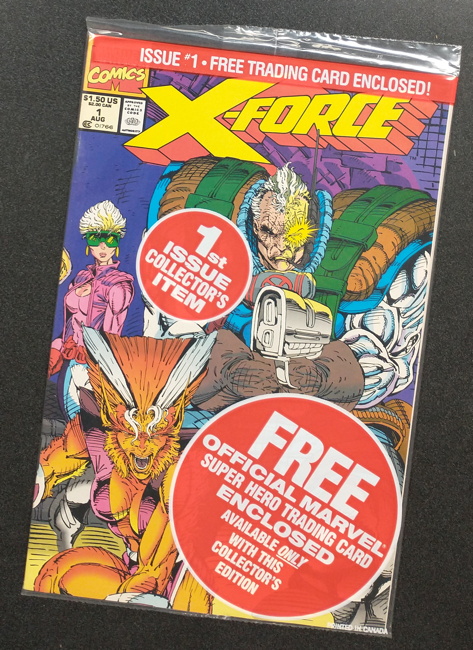
…but specifically the variation that was packaged with a Deadpool trading card (approximately one-fifth of the run, as there were five different cards):
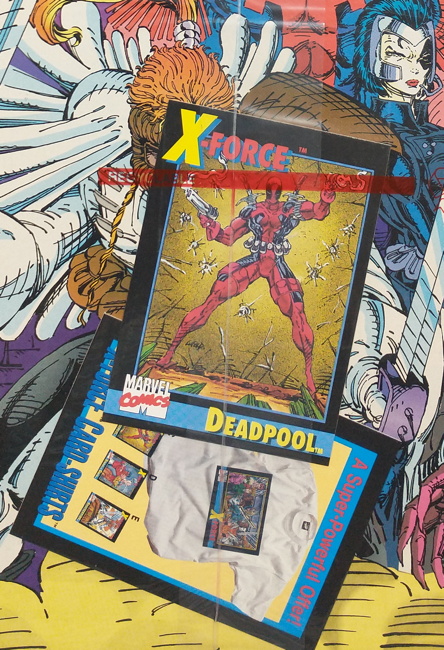
The price that I’ve seen bandied about is “$100” which apparently it did sell for on eBay, but a quick look reveals prices to be more in the $20-$40 range, which is still a lot.
And this is goaded on by the fact that this very Deadpool card, just by itself, is apparently selling for even more premium prices, with this optimistic seller offering up a graded ‘n’ slabbed one for $2600. (“Or best offer,” to be fair.)
It wasn’t that long ago…well, okay, it was 2013 when I talked about how folks didn’t seem to care much about early Deadpool appearances that weren’t New Mutants #98. And then just a couple of years back I noted my surprise at how the Deadpool-carded X-Force #1 was now (well, then) priced in the guide at $18 (which isn’t too far off from where most eBay sales are at the moment). BONUS: you can see that lovely pic of me in the second link wielding a full set of those X-Force #1s, with each card in the set represented.
There are a preponderance of these Deadpool cards listed online as “rookie cards,” which…I don’t know, is kind of weird. I mean, I guess, technically, that card is his second appearance, I think, if you want to refer to tie-in merchandise as “appearances” of characters (which leads to madness like calling an issue of Marvel Age the “first appearance” of Spider-Man’s black suit). But calling it a “rookie” card feels…well, feels like forcing the invention of collectability in a market where genuinely collectible items are becoming harder to come by.
I’ve written before (on Twitter, I think) about how this seems to be driving the current speculator market for current issues, where any first appearance, any deviation from the norm is branded “hot” and because of the very nature of current close-to-the-bone comics ordering by retailers, an already scare item becomes that much more scarce. Who needs to chase after an Amazing Fantasy #15 when you can artificially inflate demand for the first appearance of Gold Lantern, a character everyone’s already forgotten about?
Also tying into things I’ve written about before…while millions of X-Force #1 were printed, that doesn’t necessarily follow that millions are out there in readily available circulation. And the ones that do turn up aren’t necessarily going to be in that minty-mint collectable condition. I assure you, no matter how many bags or boards or Mylars or what was it, “Comic Stor” 3-ring binder sleeves were sold, I am betting, just on personal observation of having been in comics retail for nearly 33 years, that most of the copies that ended up in the hands of consumers at that time have been damaged or destroyed over the decades.
And the large amounts of unsold copies that stores still had after that initial sales window closed back in 1991? Probably vanished along with many of the stores that shut down as soon as that comics boom went bust…probably because they were stuck with too many copies of, oh, say, X-Force #1 and comics like that. So it’s possible a lot of that stock is just sitting in storage units or former retailers’ garages, with no where to go, and no access to potential buyers. Which isn’t to say a comic like X-Force #1 is “rare” by any means…just that you have have a longer search ahead of you finding copies, as not many stores open now were open then to have wholesaled them.
(NOTE: I know I’ve discussed this before, in relation to Valiant’s Turok #1. Longtime readers, I beg your patience as Old Man Mike repeats his stories.)
So anyway, does this have anything to do with X-Force #1 avec une carte à collectionner Deadpool suddenly creeping up in price? It probably doesn’t hurt, but it also appears to be tied to the current secondary market for Marvel trading cards also booming beyond belief.
For literally decades any inquiry about Marvel trading cards was always, always, without exception, even more italicized words, from people trying to sell their sets. Never looking to buy. Just trying to turn over their old card sets, and then realizing they’d get next to nothing for them because, well, nobody was buying and stores would be crazy to put any kind of premium price on these.
Well, guess what, from what I can tell looking on the eBays, about a month or so ago it was decided Marvel trading cards were hot and collectible again.
Look, I just did a quick survey, maybe this had been coming for a while, and prices had been creeping up. But in January a complete set of just the base 1990 card set, no holograms, could be had for $60, and now it goes for hundreds. A set with holograms apparently sold for over $600. And I’m sure there’s more I’m missing.
In short, when no one was looking, Marvel’s trading cards suddenly shot up in price. Even that $60 for a base set was five times the going market price on these for years. And most tellingly, within the last few days I’ve started to get actual inquiries from people looking to buy them. Granted, they’d likely want them for the traditional low prices than the new hot market prices, but that this online trend is trickling down into the real world is somewhat telling.
I suppose again it’s the idea of relative scarcity, especially after these sets were ignored and untraded in shops during the trading card lull in the comics market. Like all those hot 1990s comics, sets were probably disused into noncollectability or just lost, and retail stores that may have had inventory on these at the time are long gone. Again, more product that still isn’t reate, but now not as easy to find as it once was.
So it that what’s happening here? Marvel cards are suddenly getting hot, and now “promo” cards like that Deadpool one are being driven up in price as well along with them? If I had to guess, I’d say X-Force #1s are likely easier to track down than full sets of Marvel Universe cards…so are those Deadpool “rookies” being boosted as collectables to capitalize on the newly-resurging card market? Those Deadpool cards seem to be selling, on average, for more than the comic with said card. Should I open up the X-Force #1 I have in the store and just sell the card by itself?
Some of the eBay listings I’ve looked at don’t even mention that the card was originally a comic book insert. Do some buyers even realize that it was an insert? Do some sellers even know? It has been 30 years…a non-zero percentage of the people involved in these transactions were almost certainly not even born yet.
It all seems so amazing to me that these comics and cards after years of being mostly moribund are suddenly The Hot Tickets. But then, there was a time at the old shop when we were selling New Mutants #98 with Deadpool’s first appearance at $10 a pop and thinking this had to be some sort of crime selling them for so much. So as the market changes, I guess I gotta roll with it.
I’ve leaving that Deadpool card intact inside that X-Force #1 I had at the shop, however. Popping it open just to sell the card is a bridge too far.
So the other day I saw that comics artist Dan Panosian had posted a photo from the Deathmate promotional tour he and other artists did in the 1990s. (Here’s another pic showing more of the particpants.)
For those of you who weren’t there in the comics field during the ’90s, or were there and have since buried those memories. Deathmate was a high-profile intercomany crossover event between Image Comics and Valiant Comics. It…had some scheduling issues, shall we say, mostly on the Image side, with one chapter (Red, as they were IDed by color not issue number) coming out after the Epilogue. End result…sold well at first, then customers just kinda gave up on it partway through, leaving retailers with plenty of unsold copies.
I’ve noted Deathmate on this site here and there before, mostly in the context of how it was a symptom of/contributor to the comics market crash of the ’90s. I remember having boxes of these things in the back, and aside from a very brief flurry of interest in Deathmate Black due to it having an early appearance of the now mostly-forgotten Gen13, there were no aftermarket sales. Well, okay, that’s not entirely true, at one point at the previous place of employment we brokered a deal to sell 100,000 copies of our overstock to someone-or-‘nother for literally pennies apiece, and thus were we rid of these things. We got a nickel each, and we were glad for it.
Anyway, back to the tweet…I retweeted Mr. Panosian’s tweet with the comment about how “I’m here for Deathmate content,” which amused him. In the ensuing exchange we had (in which I assured him I wasn’t making fun, I’m genuinely interested in this period of comics) he asked “did it ever finish?”
Okay, you know publishers done screwed up when the folks who worked on the comics don’t even know if the series ever completed. I let him know “well, yes, technically” and that was that.
What amazes me most about Deathmate is how it should have been a slam dunk. Valiant was red hot, Image was red hot, a series pairing up all their characters written and drawn by strong creative teams (and they were!) should’ve sold like each copy was bagged with an original Incredible Hulk #181. And as I recall, the initial installments sold very well…and dropped off almost immediately after that. Even I tried only the first couple of issues and gave up (I think primarily because I was interested in the Valiant characters, but not so much the Image ones). The long delays on many of the books didn’t help, and despite it being emphasized that you could read the installments in any order, that apparently wasn’t true. All in all, it turned out to be a huge mess, and you should really read former Valiant honcho Bob Layton’s thoughts on the topic.
I am curious if any of you folks out there braved the entire series. My opinion of the project is based somewhat on those two issues, but mostly on the retail end of it, where I could probably have built a house using the leftover copies. I’m also curious if anyone is trying to revisit it today, as Valiant is a current thing again and, I don’t know, maybe someone out there has an interest in early Image publications? (If so, send them my way, I’ve got some Spittin’ Image to sell them, too.)
One last thing…as I was looking up those tweets, I found this one where I posted a pic of an original promotional poster for the Deathmate event. Being the wag that I am, I noted the optimism of the poster declaring the event as taking place “over the summer.” But then Twitter pal Corey outwagged me with “they didn’t specify only one summer” and fair play, sir. Fair play, indeed.
So I picked up a pretty sizeable collection of Clive Barker comics on Sunday…issues #1 through #19 of Hellraiser, with multiples of that #1, the assocated Books of the Damned series, some of the one-shot specials (like the Christmas special…yes, there was a Hellraiser Christmas special) and the Hellraiser III adaptation, some of the other Barker short story adaptations (like Dread and Son of Celluoid), a Night Breed #1, a Pinhead #1, one of those Barkerverse #1s (Harrowers, I think) and some others. Whoever collected these really like Hellraiser is what I’m trying to say.
But I’m not here to sing to you of the pleasures of Cenobites and such, but rather to talk to you about how the collection was stored. I won’t single out the company specifically…anyway, I’m pretty sure there was more than one company that made these, but the comics were stored in those stiff clear plastic envelopes, provided as a higher-end protective sleeve for your comics than your standard polypropylene or polyethylene bags, but not quite as high-end as your pricier Mylar bags. All the comics were kept in multiple binders.
Now…okay, don’t keep your comics in three-ring binders, that’s terrible. Luckily, these sleeves were specifically made for comics to be kept in such binders, so there was usually enough space there along the edge of the sleeve to prevent the comic within from getting bumped/creased by the rings of the binder themselves. I’ve seen lots of times over the years where they just used whatever plastic pouches they could find in office supply stores to hold the comics, which would slide about and bunch up whenever the binder was opened and closed, causing spine damage. Also, that seems like it would just take up too much space, frankly. But hey, to each his or her own.
Back to those fancy sleeves these Hellraiser comics were in. I remember selling lots of these back in the industry’s boom times of the early ’90s. Just boxes and boxes of them, of the 3-ring and non 3-ring variety. At the time they looked shiny and nice and felt smooth to the touch and the flaps were supple and hopefully I’m not turning any of you on, but hey, these seemed like reasonably nice sleeves. Even after the market crashed, we still have a number of boxes of these sleeves hanging around, and we could still move ’em out on occasion.
CUT TO: 25 years later, and your pal Mike is trying to go through these comics and get a good look at them before loosening his pursestrings to pay for these items. And the sleeves, once shiny and smooth and easy to open, are now, nearly every single one, cracked and split along the edges. When I open the flap to extract the comic, more often than not it cracks apart on me, usually coming right off. To the credit of these sleeves, the comics inside were well protected, which is the primary goal of putting them in sleeves in the first place. But in some cases, the bottom and/or top of the sleeves had come apart entirely, exposing the edges of the comic within to whatever elements they could have come across. It didn’t look like they had, so at least there’s that, but had they been exposed to any moisture at all, the bags would have done nothing.
My initial thought was that maybe these were just stored poorly. Maybe not somewhere wet, thankfully, but possibly somehwere with extreme temperature changes, that might have damaged these sleeves. There were a lot of people new to the hobby who entered the comics market during that period of time, who didn’t really know much about the care and feeding of comic books, and many of them didn’t stay for long. That means a whole bunch of comics bought in the late ’80s/early ’90s that eventually got discarded or neglected, shoved into some closet or out into the garage, if not just thrown out entirely, once the faddishness and interest faded.
I’m sure many of these comics were kept in fancy sleeves like the ones I’ve been talking about. The collection, ignored and shoved away, allowed to deteriorate until happened upon during housecleaning or an emptying of a storage unit, carted over to the local comics emporium for someone like me to go through them. ,,,My assumption was that poor storage brought about the demise of these sleeves, but I had at least one person tell me that, in his case, even in optimal conditions, they didn’t age well. I don’t know if that’s always the case…I have come across some of those somewhat softer but similar sleeves from the same time period, like some of those on the Wizard 1/2 mail-away offers, and they seem to be okay. But these cripser sleeves…I’ve come across them previously in recent years, and, yeah, I always end up rescuing the comics from them and throwing those sleeves away.
In conclusion…who wants to buy a bunch of Hellraiser and other Clive Barker comics? I sure do seem to have a bunch of them.
• • •
I have more Swamp Thing talk in me…surprise, surprise….including some response to your recent comments, but that’ll come later in the week. Thanks for reading, pals.
So as I was talking to my former boss Ralph about Miracleman orders, as I mentioned last time, I also had a question or two about the actual process of ordering the monthly comics back in the long-ago days of the early 1980s. You may recall that I’d been going through boxes and boxes of Ralph’s old comic company promotional materials from the early days of his shop (something I need to get back to soon, in fact). In the process of doing so, I found several retailer packs filled with order forms and publisher promos and such…no single Previews catalog like we have now, but rather pretty much every publisher supplied their own individual fliers with product information. You’d go through all these, figure out your orders, write the numbers down in the order form supplied by the distributor, and send that in.
I asked Ralph if that was as huge a pain in the ass as it seemed, and he said that, actually, no, it wasn’t. For one thing, there was a lot less monthly product to be ordered. There weren’t hundreds and hundreds of pages to plow through…I don’t have one of those old retailer packs right in front of me at the moment, but if I had to make a rough estimate, at the absolute high end all those different fliers and info sheets probably didn’t total up to more than about 100 pages. In addition, orders were probably a lot more consistent from month to month…no reboots/relaunches/crossover events/variant covers/whathaveyou making you have to ponder and re-ponder your numbers. You’d have to pay attention to things like “who’s drawing this issue?” and “is Wolverine guest-starring?” more than “how many more readers are going to bail on the book with its fifth consecutive first issue in as many years?”
Now, with the Previews catalog slowly becoming multiple booklets (as I somewhat sarcastically commented upon at the beginning of this End of Civilization post), it’s like we’re slowly returning to that time. I only half-jokingly suggested that Dynamite and IDW and so on would get their own separate product info publications…that’s how things used to be done, and maybe could again. At least, until it all goes entirely digital, and I’m squinting at an endless series of downloaded order form PDFs on my computer screen.
Anyway, one thing Ralph mentioned about ordering comics way back when was, a thing that made the actual process easier, was that with the smaller product line it was easier to keep track of things in his head, versus maintaining extensive cycle sheets, on which you could keep track of each title’s orders and weekly sales. That was fine up until the late ’80s/early ’90s comics boom, when numbers on a lot of titles suddenly exploded, and instead of 20 or 30 copies of something, you were suddenly ordering 300 copies. Even at that point, it was theoretically possible to just mentally track the numbers, but once the comics market crash hit…hoo boy.
Now keep in mind that we didn’t know that the crash was “The Crash” as it was initially happening. After a couple of years of huge, nonstop sales — “it’s like our Christmas rush never ended!” I remember saying to someone at the time — a sudden downturn wasn’t seen as an immediate problem. It was like, “oh, That’s Just Retail, it comes and goes, the customers will be back” and orders stayed up…and up, and up, and eventually the lightbulb clicks on over your head and you realize “oh, wait, this is bad.” Particularly with a two or three month lead time between making your orders and receiving them, at a time before distributors had the “Final Order Cutoffs” for retailers to adjust orders on some products a little closer to the actual release dates.
If you look back in my “market crash” category, you’ll see me talking about this sort of thing. What I haven’t mentioned is what my former coworker Rob and I used to do was make notes for Ralph in the Previews or Capital City catalogs (which by this time did exist as a retailing tool, versus all the separate booklets) and make notes next to specific title that we felt had desperately egregious differences between what was ordered and what was left over. In other words, basically saying “for God’s sake, order fewer copies of Spider-Man Unlimited” or whatever. It was this sort of thing that eventually brought us to adopting the full-on cycle sheet method of keeping track of orders versus weekly sales, rather than just depending on memory and the now completely gone consistency of numbers from month to month. Gone were the days of bumping up numbers because “if it doesn’t sell on the rack, surely it’ll sell through as back issues,” which may have been sorta true during the boom, but “cutting numbers to the bone” was the strategy of the day after the crash took full hold.
Today, at my own shop, I use a combination of methods…I don’t necessarily use full cycle sheets, but I do keep track of certain items of note, do regular checks of what is and isn’t moving on the new shelf, and otherwise just keep a close eye on sales. It’s a bit easier when I’m the one man on the job, there every day, seeing how stuff is selling. Everything that leaves the store passes through my hands (well, I mean, let’s hope) so I am directly witnessing how product is moving. It’s still tricky…sales on the previous Venom or Hulk series wouldn’t have given me any clue as to how the new relaunches would sell, for example…but for the most part, everything’s more or less consistent and I’m not having too much trouble staying on top of everything. Now, if there should be another big comics boom, I’d definitely switch everything over to detailed sales tracking, which would be a lot more work, but, you know, a good problem to have…while it lasted.
So reader John, the fella what related the horrifying yet strangely satisfying tale of the shredding and recycling of 14 long boxes of Turok Dinosaur Hunter #1, emailed recently to inform me of more bulk stashes of the ’90s funnybooks that came into his hands.
Specifically, he had several long boxes of ’90s comics, abandoned at a local storage facility, fall into his possession, multiple copies of each, all in Mylar sleeves, and all of the Usual Suspects when it comes to collections like this. Singled out by John was this photo he took of all his copies of Man of War #6 from Malibu Comics:
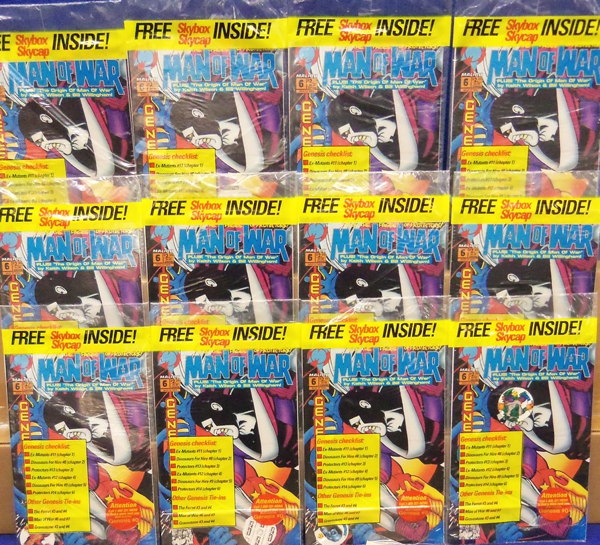
…specifically because he felt, as I am a man of poggery, I would appreciate the included pogs in each sealed factory-polybagged issue:
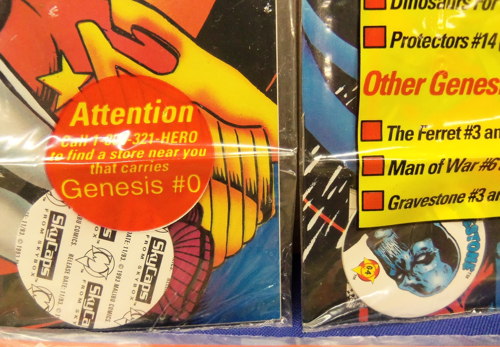
This was during the time of, of course, the Big Pog Invasion, but also during the time of Everyone Gets A Superhero Universe, including Malibu Comics which was doing this universe, with Man of War and the Ferret, while also doing the Ultraverse, with Prime and Firearm and so on. Did those two Malibu Universes ever cross over with each other? I imagine it would have been relative easy, being published by the same company an’ all, unless there’s some behind-the-scenes ownership stuff I don’t know about. Regardless, if they’d made it into the 2000s maybe that would have happened.
Anyway, there’s come collector excess for you, but at least they seem to have been kept in better shape than the comics in this tragedy. John said that the majority of the comics in this accumulation met a fate similar to the aforementioned Turok…well, not shredded in a spectacular fashion, but certainly disposed of, save for some Deadpools and a few other goodies that may actually be sellable. But here’s hoping that Man of War movie never comes to fruition, or I would weep openly on John’s behalf for such a lost lucrative opportunity.
JohnJ Week continues, as he’s left another comment to which I wanted to respond:
“And you only get a month’s rest before you have to decide how many copies of Amazing Spider-Man #800, supposedly a big 80-pages for a whopping $9.99.
“My biggest screw-up ordering comics when I had my store was over the Superman-Lois wedding special. I thought it would sell in the kind of numbers the death of Superman could have sold in if I’d known that was going to be a big news item. But they tried too hard to coordinate it with the wedding on ‘The Adventure of Lois and Clark’ on tv, which really killed off interest in the comic.”
Now for me, Amazing Spider-Man #800 isn’t quite as difficult to order as you might think. Marvel’s past $9.99 books (almost entirely special issues in the Deadpool series) I’ve ordered reasonably okay on, as I’ve got some solid sales history for Deadpool to refer to. Oddly enough, the only $9.99 issue of Deadpool I sort of blew it on was #25 [EDIT 3/11/18: actually, it’s $5.99…still blew that order, though], where I got just a few too many for inexplicable reasons and thus I’ve just kept it on the shelf, selling a copy every once in a while.
Amazing Spider-Man sales of late have been slowly increasing, probably because of the impending 800th issue, partially because of the plotlines, and partially because Marvel sales have been slowly climbing for me just kind of across the board on many of their main books. Of course, that’ll come to an end when Marvel begins their next round of relaunches, killing that momentum, but hey, maybe I’m just being cynical and this eighth or ninth time really will be the charm.
Anyway, getting back on track…even though the increased demand for Amazing Spider-Man has caught a lot of folks off guard recently, after kind of bottoming-out for a while there, I think I may have kind of a handle on orders for it now and can make a realistic guess as to how #800 will do for me. And, historically, and even still today, “anniversary” issues of Amazing tend to sell well even as back issues, so if I still have a few left over on the shelves after the initial sales window is complete, I’m not going to be too worried.
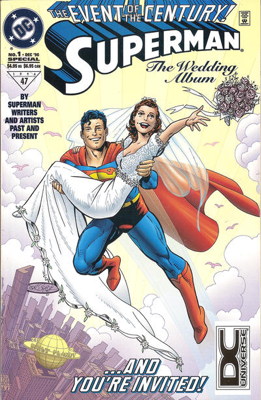 Now, the next part of JohnJ’s comment had me wondering how our own sales on the Superman wedding issues were, back at my previous place of employment. I do remember, after being caught short on 1992’s Superman #75, the black-bagged “Death of Superman” issue, we ordered much higher numbers for 1993’s white-bagged Adventures of Superman #500…and so did everyone else in the country. We sold plenty of that #500, but still were left with a boatload of them in stock. So don’t feel bad, JohnJ…that was our own “b-b-but Superman #75!” foul-up!
Now, the next part of JohnJ’s comment had me wondering how our own sales on the Superman wedding issues were, back at my previous place of employment. I do remember, after being caught short on 1992’s Superman #75, the black-bagged “Death of Superman” issue, we ordered much higher numbers for 1993’s white-bagged Adventures of Superman #500…and so did everyone else in the country. We sold plenty of that #500, but still were left with a boatload of them in stock. So don’t feel bad, JohnJ…that was our own “b-b-but Superman #75!” foul-up!
By the time 1996 and the Superman Wedding Special came around, we were still trying to recover from the comics crash, and the excesses of the late ’80s/early ’90s were mostly behind us. But our comic sales weren’t doing too badly, and there was still the occasional rush from the general public into shops whenever any particular comic hit the real world news (though, as you noted, that’s not an occurrence you can ever predict or readily depend upon). As I’ve been typing this, I’ve been trying to envision the Superman backstock boxes in the old storage room, and if I recall correctly, we did have some remaining copies of the Wedding Specials (both the white-covered Direct Edition and the John Byrne-covered Newsstand Edition, though more of the former). It wasn’t a lot, and I seem to recall selling quite a few of them on the stands, and continuing to sell them over the subsequent years (at the very least, I do remember having to fish ’em out of the back room every once in a while).
I can remember that, I just can’t recall what our initial orders were…it was a pretty good number, I think, but not so high that we were stuck with an enormous number of leftovers. And I can’t even recall if there was the aforementioned rush of folks who heard about it on the Evening News or wherever. If only I’d known I was going to be starting my comics retailing blog a mere seven years later, I would have kept better notes. Ah well, I’ll be talking to my old boss Ralph soon, so I’ll ask him and see if he remembers.
As for the Lois and Clark TV show fouling things up a bit…yeah, I do distinctly remember when the plan was to separate Lois and Clark in the comics for a bit to forestall the impending nuptials even further, complete with solicitations for future issues to that effect. Then, when the wedding was announced for the TV show, that tail wagged the dog sufficiently to cut short that separation storyline in the comics and fast-track the four-color version of the super-couple down the aisle. You can read more about that in this column by my comic article-writin’ pal Brian. …Thanks, JohnJ, for your blogging-inspirational commenting!
Now let me go back to something I said earlier in this post, regarding the Marvel “Fresh Start” publishing initiative. Perhaps I came across a little…agitated by the whole thing. I thought the recent Marvel Legacy deal was a good idea…trying to wean themselves off the constant relaunches and new #1s, focus on the lengthy histories and runs on these titles, give readers some confidence that they can follow a story without thinking it’s just going to up and restart with a new first issue. And as I said, I was seeing some improvement on many Marvel books…even Doctor Strange and Punisher were slowly climbing in sales. Will those gradual increases carry over into any new relaunched titles featuring the same characters? I sure hope so, but I don’t know.
I think what set me off was the announcement of the “new ongoing” Immortal Hulk, launching with its first issue in a few months. That made me snark a bit on the world’s primary snarking service, Twitters Dots Coms, because honestly, is there going to be an Immortal Hulk issue number, say, 35 on the stands three-something years from now? Or by “ongoing” do they mean like the old “maxiseries,” which would run a fixed 12 issues, in, out, and done? Don’t get me wrong…I’m a longtime Hulk comics fan, and Immortal Hulk sounds fine and I look forward to reading it. But…any reason why this couldn’t have just been done under the title Incredible Hulk? Does relaunching a long-running title with a new first issue still have any kind of extra selling power? Does any kind of sales boost that results stick around for any period of time? Is there a long term advantage to doing that versus just building an audience on an established title without breaking momentum with forced cancellations and restarts?
I’ve said before, I want comics to sell well. I mean, more than just because that’s how I make my living. I want comics to sell well because I like comics. And I want other people to like comics. But every single time there’s a series of relaunches like this, it really does make things difficult. It can confuse and irritate customers, and as has been said so often, jumping-on points are also jumping-off points.
It’s…a weird thing to be concerned about, I realize. It doesn’t really matter what the number is on the front of the comic so long as you’re enjoying what’s inside. Like I said above, I’ve read Hulk comics for a long time, and I’ve read them through, what, a half-dozen restarts and renumberings? But part of comic collecting is the “collecting” part, and it’s hard to escape the issue numbering mindset. These constant renumberings do have an impact, and having a big new “#1 First Issue Collector’s Item!” on the front cover isn’t quite the sales ploy it used to be.
« Older Entries
















 Now, the next part of JohnJ’s comment had me wondering how our own sales on the Superman wedding issues were, back at my previous place of employment. I do remember, after being caught short on 1992’s Superman #75, the black-bagged “Death of Superman” issue, we ordered much higher numbers for 1993’s white-bagged Adventures of Superman #500…and so did everyone else in the country. We sold plenty of that #500, but still were left with a boatload of them in stock. So don’t feel bad, JohnJ…that was our own “b-b-but Superman #75!” foul-up!
Now, the next part of JohnJ’s comment had me wondering how our own sales on the Superman wedding issues were, back at my previous place of employment. I do remember, after being caught short on 1992’s Superman #75, the black-bagged “Death of Superman” issue, we ordered much higher numbers for 1993’s white-bagged Adventures of Superman #500…and so did everyone else in the country. We sold plenty of that #500, but still were left with a boatload of them in stock. So don’t feel bad, JohnJ…that was our own “b-b-but Superman #75!” foul-up!





